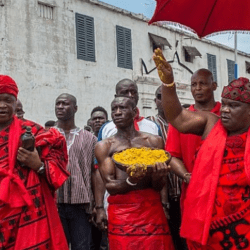For those familiar with the British Museum in London, a visit to its collection of African art can often evoke a sense of awe, especially when encountering masks from across the continent. Among the artifacts that stand out in this impressive collection is the Ife Head, a piece that holds a special place in the history of West African art. This remarkable sculpture, famously featured by former British Museum Director Neil MacGregor in his work A History of the World in 100 Objects, offers a fascinating contrast to the traditional African masks, yet shares a deep cultural and spiritual connection.
The Ife Head and traditional African masks are two sides of the same coin, reflecting the rich artistic and spiritual traditions of Nigeria and the broader African continent. While the Ife Head stands out for its extraordinary realism, it shares with African masks a deep-rooted belief in the symbolic and spiritual importance of the head. Visitors to the British Museum and other collections around the world can appreciate how these remarkable objects, though distinct in form, tell a unified story about the role of art in expressing cultural identity and spirituality.
The enduring appeal of these works of art, both exotic and familiar, lies in their universal focus on the head as a symbol of power, spirituality, and identity—an artistic theme that transcends cultural boundaries and continues to inspire and captivate audiences worldwide.
The Ife Head: A Masterpiece of West African Art
The Ife Head is a realistic brass sculpture, likely representing an Ooni, a ruler of the ancient kingdom of Ife, which flourished between AD 1100 and 1500 in present-day Nigeria. This extraordinary artifact is known for its outstanding attention to detail and lifelike quality, which distinguishes it from many other forms of African art that tend to emphasize abstraction or stylization.
When the Ife Heads were first brought to Europe in the early 20th century, their striking realism challenged the existing perceptions of African art. European explorers of the time, influenced by the racial prejudices of the era, found it difficult to believe that such sophisticated craftsmanship could have been achieved by African artists. Instead, they speculated that the heads were the work of settlers from ancient Greece, possibly giving rise to the myth of Atlantis. Despite these misguided theories, the Ife Head remains a testament to the advanced artistic techniques and rich cultural heritage of the Yoruba people of Nigeria.


The Spiritual and Cultural Importance of the Ife Head
What makes the Ife Head particularly significant in Yoruba culture is not just its craftsmanship but its spiritual meaning. In Yoruba belief, the head is considered the seat of a person’s Ase, which refers to the vital energy, inner power, and spiritual force that guides an individual’s life. The detailed portrayal of the head in Ife art reflects the reverence for this spiritual energy and highlights the centrality of the head in Yoruba cosmology.
African Masks and the Significance of the Head
The connection between the Ife Head and traditional African masks lies in their shared focus on the head as a symbolic and spiritual element. While masks often depict either human or animal heads, they serve a different function from the more static, royal Ife sculptures. African masks are typically used in rituals, dances, and social ceremonies, where they act as conduits for the spirits, ancestors, or deities they represent.
Like the Ife artists, many African cultures also hold the belief that the head contains a person’s life force or spiritual essence. This may help explain why masks and head sculptures are such prevalent forms in African art—they are not merely decorative objects but powerful symbols connected to identity, spirituality, and the broader universe.
The Exotic and Familiar Nature of African Masks
African masks have a universal appeal that makes them feel both exotic and familiar to global audiences. One reason for this might be the symbolic importance of the head across different cultures. The head, as the locus of thought, identity, and spirituality, has been a focal point in art worldwide, from ancient Greek busts to modern portraiture. This commonality allows viewers to connect with African masks, even if their specific cultural or ritual contexts are unfamiliar.
Moreover, the influence of African masks on 20th-century Western art movements such as Cubism and Expressionism has contributed to their global resonance. Pioneers of modern art like Pablo Picasso and Henri Matisse drew inspiration from the bold forms and abstraction found in African masks, which pushed the boundaries of Western artistic conventions and introduced new ways of depicting the human face.
Neil MacGregor and the Ife Head’s Role in Global Art History
Neil MacGregor’s inclusion of the Ife Head in his influential book A History of the World in 100 Objects underscores the importance of this piece not only to African history but to the broader narrative of world art. By showcasing the Ife Head, MacGregor highlights the advanced artistic and cultural achievements of ancient Africa, challenging outdated views that underestimated the complexity of African societies.
He also emphasizes Ife’s status as the spiritual heartland of the Yoruba people, a place where art, religion, and royalty were intricately intertwined. The Ife Head, with its exceptional realism and symbolic significance, represents more than just an artistic achievement; it embodies the rich spiritual and cultural identity of the Yoruba.
A Shared Artistic and Spiritual Legacy
The Ife Head and traditional African masks may differ in form and function, yet they share a deep spiritual connection through their depiction of the head and its symbolic importance. Both forms of art offer insight into the ways in which African cultures view the head as a vessel of power, identity, and connection to the divine.
The realism of the Ife Head contrasts with the abstraction found in many masks, yet both approaches convey a profound respect for the head’s spiritual significance. Whether in the stately portrayal of an Ooni or the dynamic masks used in ceremonial dances, African art reflects a shared belief in the power of the head to embody Ase—the spiritual energy that drives human life.









